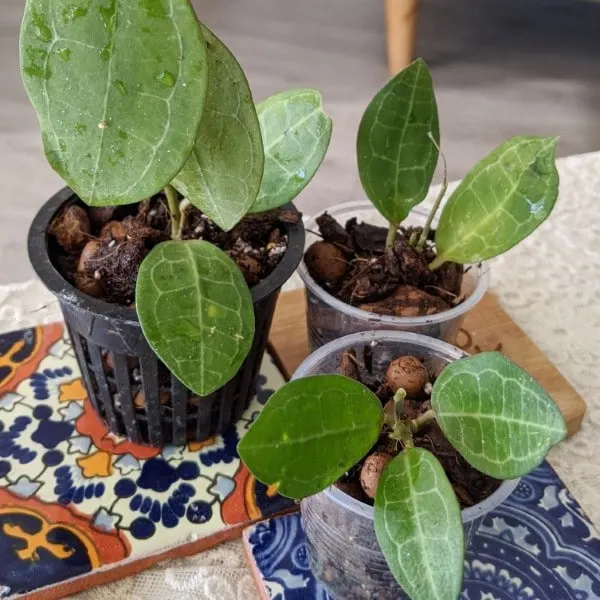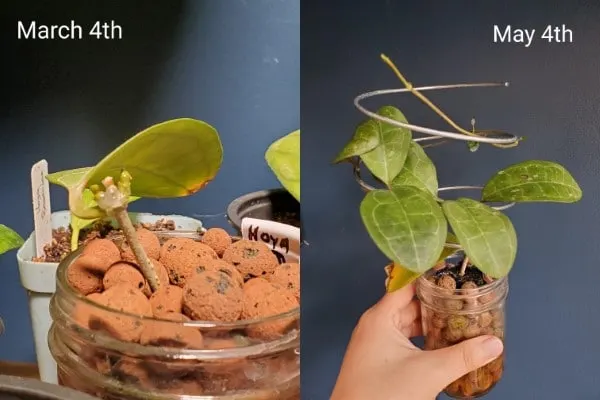The Hoya Elliptica has some of the most beautiful and hard to get flowers out of all the Hoyas. It has small star-shaped white or pale white flowers, with purple or yellow middle sections. As we said, these flowers are hard to get because of how challenging it is to care for a Hoya Elliptica.
The following sections will categorically explain what you need to do to keep your house filled with the fragrance of Hoya Elliptica flowers.

Caring for the Hoya Elliptica (The Essentials)
The Hoya Elliptica happens to be a resilient but paradoxically frail plant. If witnessed in its nativity, this plant can withstand anything. However, when removed from its natural habitat to the safety of modern houses, this plant becomes weak and dependent.
It is your responsibility to take care of this plant. The good news is once you master and understand the basic requirements of this plant, caring for it becomes easier. The basic needs are all related to:
- Light intensity
- Temperature
- Soil pH
- Potting/Repotting
- Pruning
- Watering
- Fertilizing the Soil
Light Intensity
The Hoya Elliptica needs a lot of light to grow, but the crucial part is the intensity of light. A Hoya Elliptica should get light that is as intense as the morning sun’s rays.
Sunlight from mid-day sun will bleach its leaves and may even damage the peduncles. Whereas, too little sunlight will delay its blossoming period and may even negate or eliminate it altogether.
You have to find a balance between the amount of light it receives. Try to keep in a position or place where it is exposed to direct sunlight during the early hours but indirect light throughout the rest of the day.
Temperature
Ideally, the Hoya Elliptica should be kept in a moderately warm area, where the temperature remains between 60 to 85 degrees Fahrenheit. Along with the temperature, the humidity for a Hoya Elliptica should also be kept between 40% to 60%.
For the temperature, you can use a radiating light source. For the humidity, you should use an air humidifier. If you live in a cold region, you’ll have to go out of your way to save your Hoya Elliptica from the prickly spears of the icy cold.
The pH of the soil
Ideally, the Hoya Elliptica should be placed in soil that has a pH of 6 to 7. The Hoya Elliptica thrives in neutral soil, so you have to maintain it through the right additions. If the soil becomes too acidic, use liming agents to reduce the acidity.
You can use numerous testing kits available in the market to check the pH of your soil. A small indicator of soil imbalance is the wilting in the vines and stems of the Hoya Elliptica. The leaves also become paler and frailer.

Potting and Repotting
The Hoya Elliptica should be put in a pot that has soft and airy soil. The ideal Soil for Hoya Elliptica should be peat-based with a bit of perlite. The ratio of peat to perlite should be 2 to 1. This combination allows the roots of the Hoya Elliptica to breathe.
Peat-based soils also allow water to drain off quickly, which means the Hoya Elliptica’s roots won’t drown in the water. You should use an appropriate pot that allows for water drainage; you can get one easily from a local vendor.
Pruning
The Hoya Elliptica is a slow grower, so you don’t need to prune it often. However, ignoring its pruning is not out of the question as well because its vines can grow longer than 15 ft. If you don’t have any support for the vines to cling to, they can get cluttered and lead to overcrowding near the central stem.
Prune and get rid of the discolored leaves. If a vine is weakening or is excessive, you should get rid of it. In the end, it all comes down to the designs you have in mind. You can prune and fashion it as you like, as long as you don’t get harm the peduncles.
Watering
You should water the Hoya Elliptica more in summer compared to winter. Typically, the Hoya Elliptica should be watered three times per week in summers. Don’t let the middle soil dry out. You’ll have to water it four times per week around spring when the Hoya Elliptica blossoms.
During winters, the Hoya Elliptica stops growing, so you should water it rarely. Wait for the middle soil to dry before watering it again in the winter. Mist your Hoya Elliptica as well, to give it leave the right humidity and hydration.
Fertilizing the Soil
To fertilize the Hoya Elliptica, use bloom boosters that are soluble in water. Dilute the fertilizer in water and then apply it. Never apply fertilizer to dried soil. Water your Hoya Elliptica and then water it to allow for drainage.
You should also remember when to use fertilizer. Don’t fertilize the Hoya Elliptica in winter either because they don’t need fertilizer in winter. The growth of the Hoya Elliptica bottoms out, so there is no need for fertilizer.
How do you propagate the Hoya Elliptica?
You can propagate a Hoya Elliptica through its seeds, stems, or leaves. The seed propagation method is mostly for commercial growers of the plant.
The stem propagation method and leaf propagation methods are for home growers. We do not recommend the leaf propagation method because it takes close to a year to get results.
Instead, cut a healthy stem from your Hoya Elliptica, and prune the leaves close to the bottom. Place the stem in a water container and wait for it to grow roots.
The water in the water container should be changed every once in a while to stop stagnation. Once it grows roots, place it in the soil and care for it as you would for a Hoya Elliptica.
Conclusion
The hardest part of caring for a Hoya Elliptica is understanding the basics. Once you get that learning curve out of the way, you only need a bit of motivation to stay true to your goal, at least until its first bloom.
Trust us; once you see your Hoya Elliptica blooming, you’ll remain dedicated to its care for the rest of your life.
